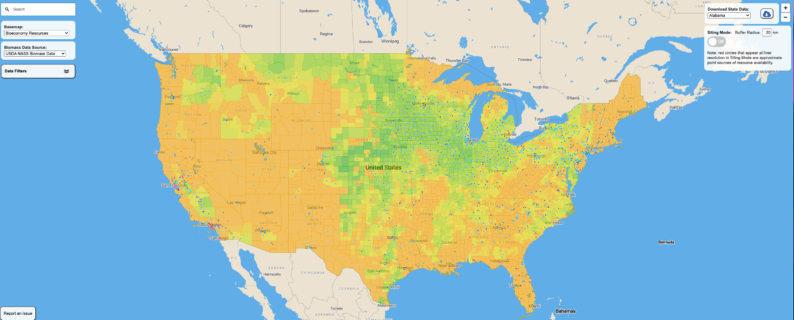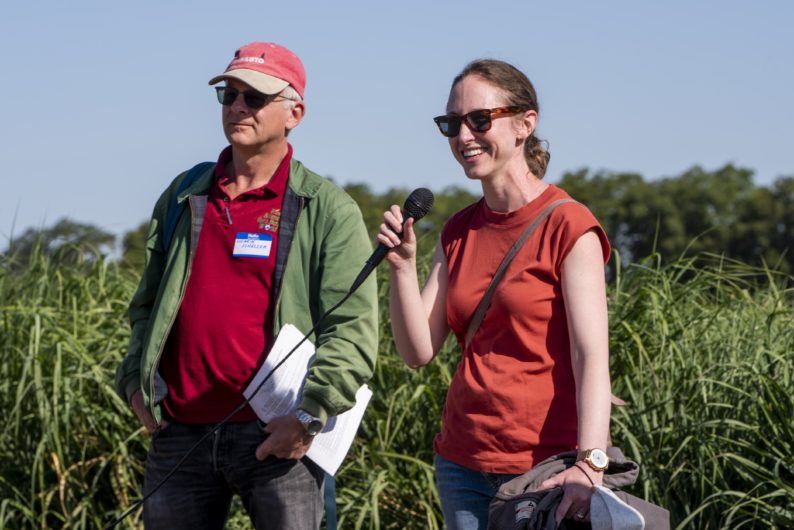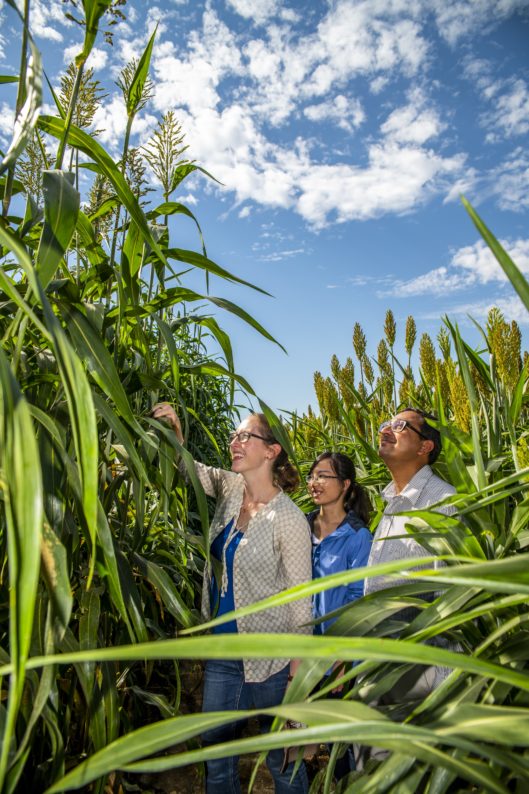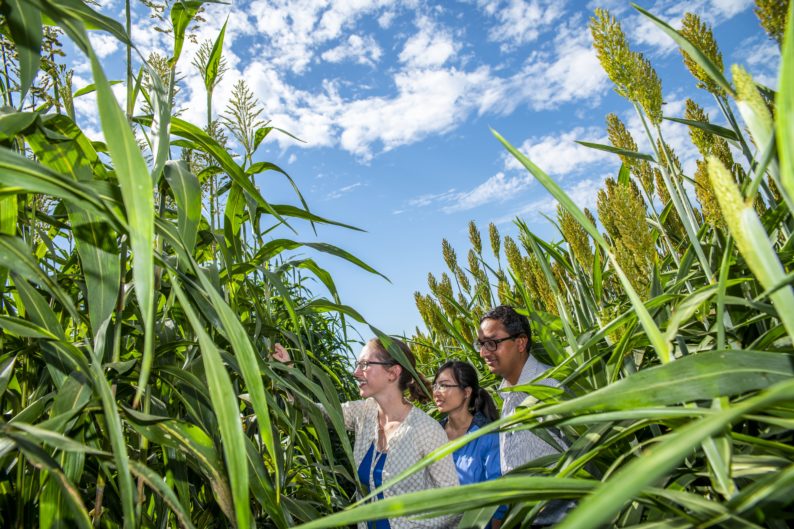We recently spoke with members of the Joint BioEnergy Institute (JBEI)’s Life-Cycle and Techno-economic Analysis team to learn more about their work and how it informs and enhances JBEI’s research. JBEI is at the forefront of creating biological processes that produce sustainable fuels and products. This approach is of great importance in addressing energy security, equity, and sustainability — so much so that the Biden Administration issued the National Biotechnology and Biomanufacturing Initiative in September 2022.
What is life-cycle and techno-economic analysis?
Life-cycle and techno-economic analysis is a field of study that helps researchers understand the economic and environmental impacts of an early-stage technology. At JBEI, that’s typically a biofuel or bioproduct technology.
These analyses are a key part of making sure biofuels and bioproducts can compete with and eventually replace fuels and products made from fossil fuels.
In particular, techno-economic analysis is used to determine the cost associated with scaling up an early-stage technology.
“In this case, you’d have data generated by researchers working in the lab and you’re interested in looking at what will happen if you were to scale up your technology,” said Corinne Scown, Vice-President for Life-Cycle, Economics and Agronomy and Director of Life-Cycle and Techno-economic Analysis at JBEI. “Techno-economic analysis fills in the gaps and simulates what this whole process would look like.”
There are several financial metrics of interest, but the one most often used by JBEI scientists is minimum selling price — the minimum price a biofuel or bioproduct must be sold for to guarantee a reasonable return (typically 10%) on the company’s investment.
“If that minimum selling price turns out to be much higher than current market value, it prompts the researchers to reevaluate their strategy,” Scown said. “Perhaps there is a better strategy to make that same molecule, or they can select an entirely different product with fewer competing options.”
Another key metric that arises from techno economic analysis is mass and energy balance, which is essentially all the inputs and outputs associated with a hypothetical production facility. This includes everything from materials to how much electricity is being used.
Detailed mass and energy balances are important for life-cycle assessments, which determine the environmental impacts of a product’s entire life cycle — everything from production and distribution to use of the actual product.
“At the end, we can report a life-cycle greenhouse gas footprint,” Scown said. “There are a lot of decisions and expert judgment that go into that, but we roll it up into a simple set of results.”
What are some examples of how life-cycle and techno-economic analysis benefit research?
Scown described one example that arose from a conversation with JBEI researcher Patrick Shih.
At the time, researchers in JBEI’s Feedstocks Division were starting to work on a strategy that involved engineering crops to accumulate bioproducts that can be extracted directly from the plant. This would be in addition to what could be made from these crops when they are harvested and further processed, like fuels or bioproducts.
Shih raised the question at a JBEI annual meeting: How much of a given product would need to be accumulated directly in crops to make it worthwhile to extract and sell it?
“It was one of those classic conversations you have at a poster session where you’re just hanging out,” Scown said. “We were both just like, yeah, this is a doable analysis. We can answer this question that no one’s answered before.”
That conversation resulted in research that provided a rule of thumb in terms of how much of a given product needs to be accumulated to make it worth it economically — assuming the rest of the biomass can later be converted into a fuel.
“Essentially what we found is: if you’re trying to make an expensive, high value product, you don’t have to accumulate much. If it’s a cheaper commodity product, you have to accumulate more,” Scown said. “That was really useful for the Feedstocks Division because they realized what they were studying was doable. It provided validation that they should keep doing what they’re doing.”
For most researchers, analyses like these — and techno-economic analyses in particular — have been largely unattainable.
“In most cases, you’d need several people with advanced degrees or you’d need to purchase expensive software packages to do these analyses,” Scown said.
In an effort to make these analyses more accessible, Scown’s team has developed various software tools that are available to the general public. These tools allow researchers to do things like browse available biomass resources around the country or calculate costs and greenhouse gas footprints.

One of these software tools, called Bio-Cradle-to-Grave (BioC2G), is a user-friendly platform for evaluating the production costs, greenhouse gas emissions, and water usage of a wide range of bioproducts.
“Users don’t need to have process engineering or programming skills to use BioC2G,” said JBEI postdoctoral researcher Nawa Baral. “Our users have included researchers, consultants, bioenergy production companies, venture capitalists seeking to evaluate new projects, and startups seeking basic information on cost and emissions.”
The Advanced Biofuels and Bioproducts Process Development Unit (ABPDU), a facility at Berkeley Lab that collaborates with industry to commercialize bio-based products, has used these tools to help their partners.
Eric Sundstrom, a staff scientist at ABPDU, said their collaborators who are in early stages of development often lack the in-house expertise or resources necessary to conduct independent techno-economic analyses.
At the same time, many of the most impactful technical decisions are made at this stage of a company’s development. These decisions require at least a base-level analysis of technical feasibility, he said.
“Having a publicly accessible tool like BioC2G can really help these teams — and their potential funders — rapidly assess new technologies, allowing them to make key decisions on process design and allocate resources toward the most pressing challenges,” Sundstrom said.
How does life-cycle and techno-economic analysis fit into how research is done at JBEI?
The Life-Cycle and Techno-economic Analysis team participates in all stages of research at JBEI — from early-stage scoping to reflecting on how research is progressing and picturing how research would translate to the real world.
Several years ago, Scown’s team analyzed market sizes and greenhouse gas footprints to provide recommendations on what commodity chemicals JBEI should be prioritizing.
“We don’t use these metrics exclusively to decide what to work on, but it’s a part of our decision making process,” Scown said.
The team also interacts with JBEI researchers later in the research process, when they’ve achieved a proof of concept but want to know what metrics to focus on to ensure they’re making progress.

The team also helps take stock of how JBEI as a whole is progressing toward its long-term goals. This often means interacting with JBEI’s Research Committee to discuss the “gold standards” coming out of each JBEI research division. They then analyze how these standards can work together and simulate what that would look like in a hypothetical production facility.
“It’s actually a pretty fun process,” Scown said. “It facilitates a really useful conversation where everybody has to put the puzzle pieces together and identify the research gaps and whether we’re heading in the right direction.”
How has life-cycle and techno-economic analysis impacted the progression of JBEI research?
JBEI’s earlier research focused on using a deconstruction process that used ionic liquids — salts that are liquid at room temperature — to break down biomass and create fermentable sugars. The process was highly effective, but it required a costly and emissions intensive water-washing process to recover the ionic liquid so it could be used again.
“When our group simulated this process, we found it created so much wastewater that had to be treated, which is expensive to do,” Scown said. “This would especially be a problem for early-stage companies. The smaller the facility is, the more burdened they’d be by this.”
This analysis informed JBEI’s switch to using biocompatible ionic liquids, an approach that has been highly successful.

Another analysis that has informed research directions was described in a recent paper led by JBEI postdoctoral researcher Minliang Yang. The paper set out to answer a question that came up in their earlier research on engineering crops to directly accumulate bioproducts.
“We had proven that at certain accumulation rates, it would be worthwhile to extract certain products made directly in the crops themselves,” Scown said. “But what if you have a microbial process that does the same thing and can be done at a lower cost? How do these compete?”
The team conducted a detailed techno-economic analysis comparing plant and microbial production of four bioproducts that have a wide range of applications and market values in the future bioeconomy. They established “breakeven” points that help the research community understand how to set realistic performance targets for yields and accumulation rates.
“Though both systems play critical roles in replacing petroleum-based products, the findings of this study can help scientists prioritize their research efforts in either plant or microbial production based on their relative advantages,” said Minliang Yang. “This also helps them evaluate progress toward economically viable bioproduction at commercial scale.”
What role will life-cycle and techno-economic analysis play as biomanufacturing advances?
Scown believes life-cycle and techno-economic analysis will continue to be an integral part of decision making in biomanufacturing research and its influence extends well beyond academic and national labs. The unique combination of engineering expertise, systems thinking, coding skills, and an enthusiasm for learning the underlying science have become essential to the development and commercialization of new technologies for climate change mitigation. In recent years, she’s seen a dramatic increase in demand for these skills in industry.
She also believes it will continue playing a key role on the regulatory side. Scown recently contributed to a report that described how life-cycle analysis methods can, and should, be leveraged to support a federal low carbon fuel standard — a policy that would require fuels to meet a specific greenhouse gas emissions target.
“We have to have really solid data and methods underpinning whatever we claim is greenhouse gas mitigation or sequestration,” Scown said.
This was a key point Scown also made in her recent analysis on carbon-negative biomanufacturing, which is the idea that biomanufactured products can remove carbon dioxide from the atmosphere and “lock” them up in a stable form.
There have been claims about biomanufacturing processes being carbon negative, Scown said, but only a subset of biomanufactured products will actually stay in their stable form.
“We need to make sure we’re doing the proper analyses so that, when we take credit for carbon removal in the biomanufacturing space, the thing we’re making actually does end up keeping carbon in a stable form,” Scown said.
Any effort that helps us shift away from petroleum is beneficial, Scown said, but she encouraged the research community to look at biomanufacturing from a different perspective.
“I urged people to think about biomanufacturing not so much as a carbon removal strategy, but as a strategy for enabling a circular bioeconomy,” Scown said. Simply put, a circular bioeconomy is an economy that revolves around minimizing waste and replacing traditional petroleum-based products with renewable, bio-based products.
As life-cycle and techno-economic analysis becomes more accessible and more research groups create open source tools, Scown sees a general shift toward more transparency.
“You shouldn’t have to be an expert to do this,” Scown said. “It’s going to take time, but we’re going to continue to do this work and make resources available to the community. I personally think that’s how I can have the greatest impact — by making it available to everyone.”
